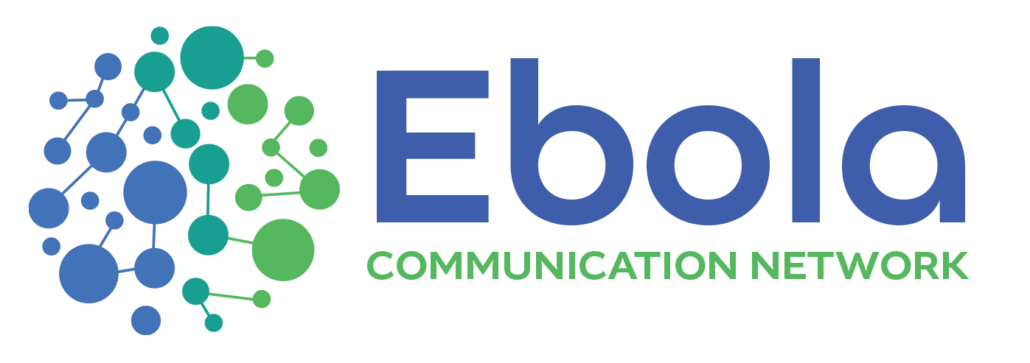How to conduct safe and dignified burial of a patient who has died from suspected or confirmed Ebola virus disease
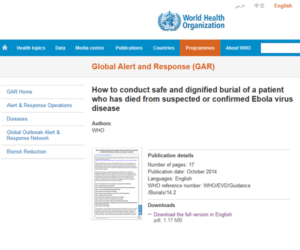 How to conduct safe and dignified burial of a patient who has died from suspected or confirmed Ebola virus disease
How to conduct safe and dignified burial of a patient who has died from suspected or confirmed Ebola virus disease
 How to conduct safe and dignified burial of a patient who has died from suspected or confirmed Ebola virus disease
How to conduct safe and dignified burial of a patient who has died from suspected or confirmed Ebola virus disease
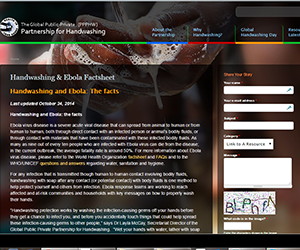 A factsheet on the role of handwashing with soap and Ebola from the Global Public-Private Partnership for Handwashing (PPPHW).
A factsheet on the role of handwashing with soap and Ebola from the Global Public-Private Partnership for Handwashing (PPPHW).
More handwashing resources from PPPHW.
 A fact sheet with frequently asked questions from the World Health Organization.
A fact sheet with frequently asked questions from the World Health Organization.
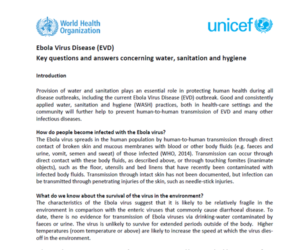 Provision of water and sanitation plays an essential role in protecting human health during all disease outbreaks, including the current Ebola Virus Disease (EVD) outbreak. Good and consistently applied water, sanitation and hygiene (WASH) practices, both in health-care settings and the community will further help to prevent human-to-human transmission of EVD and many other infectious diseases.
Provision of water and sanitation plays an essential role in protecting human health during all disease outbreaks, including the current Ebola Virus Disease (EVD) outbreak. Good and consistently applied water, sanitation and hygiene (WASH) practices, both in health-care settings and the community will further help to prevent human-to-human transmission of EVD and many other infectious diseases.
Ebola Virus Disease (EVD) Key questions and answers concerning water, sanitation and hygiene
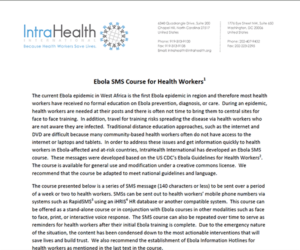 These messages were developed based on the US CDC’s Ebola Guidelines for Health Workers[1]. The course is available for general use and modification under a creative commons license. IntraHealth recommends that the course be adapted to meet national guidelines and language.
These messages were developed based on the US CDC’s Ebola Guidelines for Health Workers[1]. The course is available for general use and modification under a creative commons license. IntraHealth recommends that the course be adapted to meet national guidelines and language.
The course presented here is a series of SMS message (140 characters or less) to be sent over a period of a week or two to health workers. SMSs can be sent out to health workers’ mobile phone numbers via systems such as RapidSMS[2] using an iHRIS[3] HR database or another compatible system.
Ebola SMS Messages for Health Workers
[line][1] http://www.cdc.gov/vhf/ebola/hcp
[3] http://www.ihris.org/ iHRIS is currently being used by 19 countries to manage over 1 million health worker HR records.
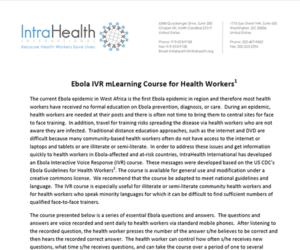 IntraHealth International has developed an Ebola Interactive Voice Response (IVR) course. These messages were developed based on the US CDC’s Ebola Guidelines for Health Workers[1]. The course is available for general use and modification under a creative commons license. We recommend that the course be adapted to meet national guidelines and language.
IntraHealth International has developed an Ebola Interactive Voice Response (IVR) course. These messages were developed based on the US CDC’s Ebola Guidelines for Health Workers[1]. The course is available for general use and modification under a creative commons license. We recommend that the course be adapted to meet national guidelines and language.
The IVR course is especially useful for illiterate or semi-literate community health workers and for health workers who speak minority languages for which it can be difficult to find sufficient numbers of qualified face-to-face trainers.
The course presented here is a series of essential Ebola questions and answers.
Ebola mLearning Course for Health Workers
[line]
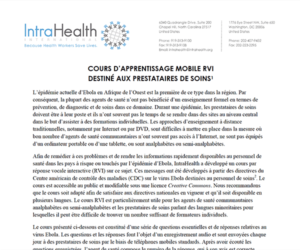 IntraHealth International has developed an Ebola Interactive Voice Response (IVR) course. These messages were developed based on the US CDC’s Ebola Guidelines for Health Workers[1]. The course is available for general use and modification under a creative commons license. We recommend that the course be adapted to meet national guidelines and language.
IntraHealth International has developed an Ebola Interactive Voice Response (IVR) course. These messages were developed based on the US CDC’s Ebola Guidelines for Health Workers[1]. The course is available for general use and modification under a creative commons license. We recommend that the course be adapted to meet national guidelines and language.
The IVR course is especially useful for illiterate or semi-literate community health workers and for health workers who speak minority languages for which it can be difficult to find sufficient numbers of qualified face-to-face trainers.
The course presented here is a series of essential Ebola questions and answers.
[line]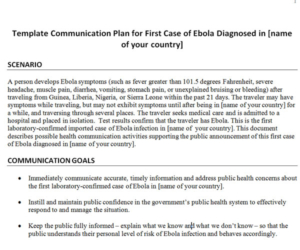 This document describes possible health communication activities supporting the public announcement of this first case of Ebola diagnosed in your country.
This document describes possible health communication activities supporting the public announcement of this first case of Ebola diagnosed in your country.
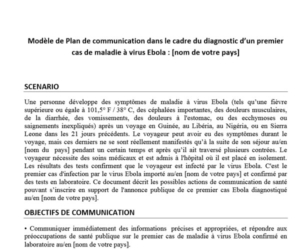 Templated Plan for Announcing First Case of Confirmed Ebola (French – PDF )
Templated Plan for Announcing First Case of Confirmed Ebola (French – PDF )
Templated Plan for Announcing First Case of Confirmed Ebola (French – Word Version)

The Ebola Communication Network was originally developed by the Health Communication Capacity Collaborative (Cooperative Agreement #AID-OAA-A-12-00058) and expanded under Breakthrough ACTION (Cooperative Agreement #AID-OAA-A-17-00017) both under the leadership of Johns Hopkins Center for Communication Programs. This website is now maintained by Johns Hopkins Center for Communication Programs and its contents are the sole responsibility of CCP. The contents of this website do not necessarily reflect the views of USAID, the United States Government, or Johns Hopkins University.
